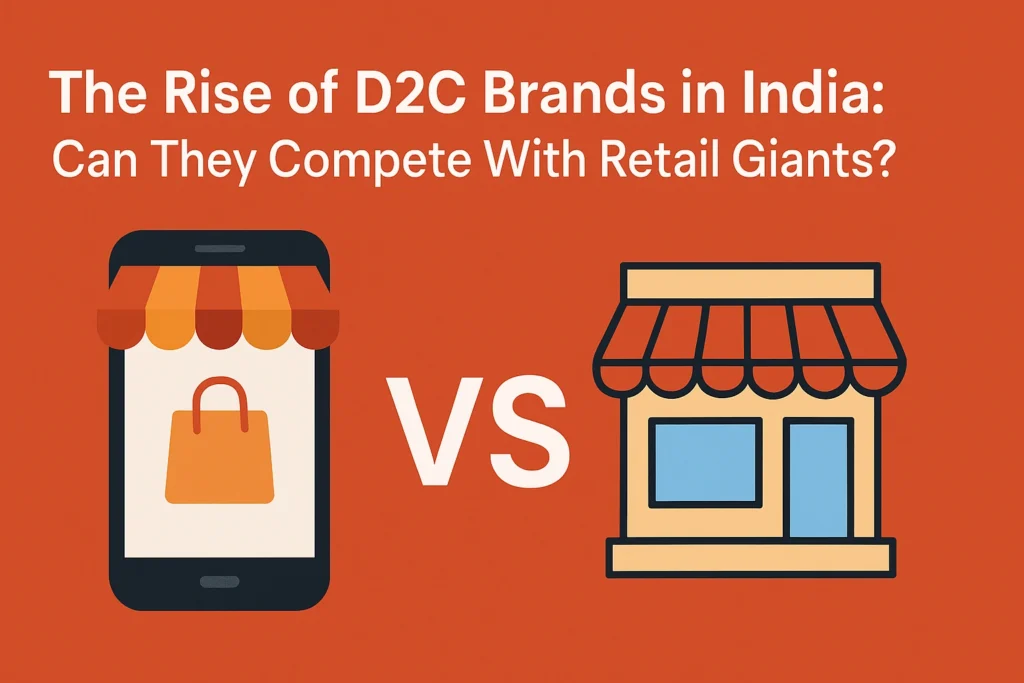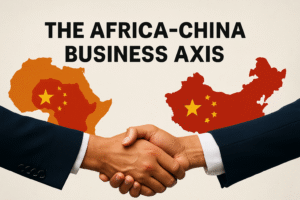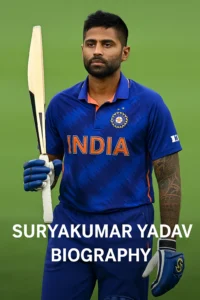Can India’s D2C Brands Survive the Retail Juggernauts?

A visual comparison between direct-to-consumer shopping on mobile and legacy retail outlets—capturing the transformation of Indian commerce.
By Somya Prabhat | Newslyy.com
A decade ago, buying personal care products meant choosing between big names on supermarket shelves—Dove, Pantene, Nivea. Fast forward to 2025, and a different story is unfolding on millions of Indian screens. The average 23-year-old consumer, scrolling through Instagram, is more likely to click “buy now” on a lesser-known brand like Minimalist, Bombay Shaving Company, or The Whole Truth. These aren’t flukes. They’re part of a bigger wave reshaping how Indians shop—the rise of D2C brands in India.
But as these startups ride the digital boom, a looming question arises: can they truly go head-to-head with India’s retail giants?
Table of Contents
1. What Exactly Is a D2C Brand?
D2C, or direct-to-consumer, sounds simple—cut out the middleman, sell directly online. In practice, it’s far more than logistics. It’s a business philosophy rooted in storytelling, community-building, and product agility.
Most D2C brands in India emerged from urban frustration. Tired of generic mass-market options, young founders sought to offer products that were cleaner, more ethical, more relatable. Take Mamaearth, for instance—it began as a toxin-free brand for babies, pitched by a mom. Today, it’s listed on the stock exchange.
Others like Boat started with affordable headphones, branding them like fashion accessories. What they sold wasn’t just tech—it was attitude.
2. Why D2C Took Off in India
Several factors converged at just the right time:
- Affordable internet through Jio’s revolution gave millions access to e-commerce.
- COVID-19 lockdowns forced digital adoption, even in households that never trusted online shopping.
- Millennials and Gen Z became the dominant buyer group—individualistic, digital-native, and loyal to brands that reflect their identity.
According to a report by Statista, India’s online retail penetration has nearly doubled in the last five years. Within that, D2C brands in India now represent a fast-growing segment, predicted to reach $60 billion by 2027.
But rapid growth doesn’t guarantee staying power.
3. Why the Road Gets Bumpy After Initial Success
Talk to founders of successful D2C startups and they’ll admit: the honeymoon phase ends quickly.
One major hurdle is profitability. Customer acquisition costs (CAC) are rising dramatically. Running paid ads on Meta or Google used to be cost-efficient, but now it’s a race of budgets. In fact, many D2C brands burn through venture capital just to keep showing up in your Instagram feed.
Then there’s logistics. Shipping across India is no small feat. While urban delivery is fast and efficient, rural penetration still lags, especially for premium-priced or niche products.
Lastly, D2C fatigue is real. As new brands flood social media daily, standing out becomes harder. A face cream from one brand might look identical to the next, despite different promises. In a market flooded with choices, consumer trust swings fast.
4. Meanwhile, Retail Giants Are Evolving
The big players haven’t been idle. Tata, Reliance Retail, and Hindustan Unilever have been quietly watching—and moving.
- Tata acquired beauty retailer Nykaa’s rival Purplle.
- Reliance is onboarding boutique brands through JioMart and launching in-house alternatives.
- HUL has invested in digitally-native brands like The Moms Co.
These companies bring something that D2C startups often lack: scale.
When Reliance decides to launch a skincare line, it leverages thousands of stores, logistics fleets, and pricing power D2C brands can’t match. And when a Unilever brand offers 20% off on Amazon and Big Bazaar simultaneously, it’s hard to ignore.
Still, the giants are adapting too—many now mimic D2C tactics. They’re investing in storytelling, influencer marketing, and even launching “limited drops” to mimic the exclusivity of D2C offerings.The rise of D2C brands in India has reshaped how consumers shop—direct, digital, and deeply personalized. From skincare to snacks, D2C brands in India are disrupting traditional retail models by building direct relationships with customers. But as e-commerce giants and offline chains fight back, the question is whether D2C brands in India can retain their edge—or risk being squeezed out of the market they helped create.
5. Can They Coexist? Or Is a Shakeout Coming?
Not all D2C brands need to—or should—go head-to-head with retail titans. The real opportunity may lie in strategic coexistence.
Brands like Wakefit, which began online, now operate showrooms. Bombay Shaving Company sells through e-commerce and also shelves its razors in offline retail. The hybrid model allows visibility without losing the personal connection of D2C.
Interestingly, many founders don’t view acquisition as defeat. For them, being acquired by a Tata or HUL is validation. It provides scale, resources, and longevity.
The era of “us vs them” might already be over.
6. What Consumers Really Want
At the heart of this shift is a more conscious Indian consumer. They’re not buying from D2C brands because they’re cheaper—often, they’re not. They’re buying for:
- Transparency in ingredients
- Ethical sourcing
- Personalized recommendations
- A brand story they can connect with
That’s why the most successful D2C brands in India aren’t those with the most money, but the most trust. And trust takes time.
You may also like (BRICS Challenging the U.S. Dollar in 2025: The Quiet Shake-Up of Global Finance)
Final Word
D2C brands in India are not a trend—they’re a reflection of India’s changing middle class. As digital natives become household decision-makers, this shift will only grow.
Retail giants may have reach and resources. But D2C brands have something rare in the Indian business ecosystem: authenticity. Whether they survive, thrive, or get absorbed, they’ve already forced an industry-wide rethink.
And that alone makes them worth watching.
Also go through (The D2C revolution: How Indian brands are redefining retail)






1 thought on “Can India’s D2C Brands Survive the Retail Juggernauts?”